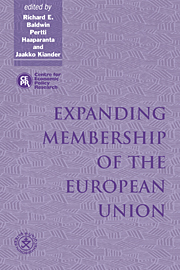Book contents
- Frontmatter
- Contents
- List of figures
- List of tables
- Preface
- Acknowledgements
- List of conference participants
- 1 Introduction
- PART ONE THEORETICAL ISSUES
- PART TWO POLICY ISSUES
- 5 Voting power and control in the EU: the impact of the EFTA entrants
- 6 Migration in the integrated EU
- 7 Trade effects of regional aid
- PART THREE EMPIRICAL ISSUES
- Index
7 - Trade effects of regional aid
Published online by Cambridge University Press: 05 November 2011
- Frontmatter
- Contents
- List of figures
- List of tables
- Preface
- Acknowledgements
- List of conference participants
- 1 Introduction
- PART ONE THEORETICAL ISSUES
- PART TWO POLICY ISSUES
- 5 Voting power and control in the EU: the impact of the EFTA entrants
- 6 Migration in the integrated EU
- 7 Trade effects of regional aid
- PART THREE EMPIRICAL ISSUES
- Index
Summary
Introduction
One of the most serious points of disagreement during the negotiations over the Maastricht Treaty involved the regional aid policies, with their implied financial transfers. The poorest countries of the EU (Spain, Greece, Ireland and Portugal), led by Spain, threatened not to ratify the Treaty if the regional aid budget to finance public infrastructure investment in the EU's poorest regions was insufficient. The Commission sided with these countries, arguing that economic disparities in Europe would endanger the social and political cohesion of the EU and therefore the objective of trade and monetary integration set in the Single European Act (1986) and in the Maastricht negotiations.
This issue finds its origins in the admission of Greece (1981), Spain and Portugal (1986) to the then EC. Although the European Regional Development Fund (ERDF) was set up in 1975, the entry of these three countries increased the disparity between poor and rich regions in the EC and was at the origin, starting in 1989, of financial transfers of unprecedented scale. Trade integration was acceptable to these new entrants, who have lower per capita GDP levels than the EU average, only under the condition that it would not cause divergence of incomes from the EU level. These countries were concerned that the positive effects of European trade integration, such as the growth effects identified by Baldwin (1989), might not be shared equally by all European regions.
- Type
- Chapter
- Information
- Expanding Membership of the European Union , pp. 166 - 190Publisher: Cambridge University PressPrint publication year: 1995
- 7
- Cited by



